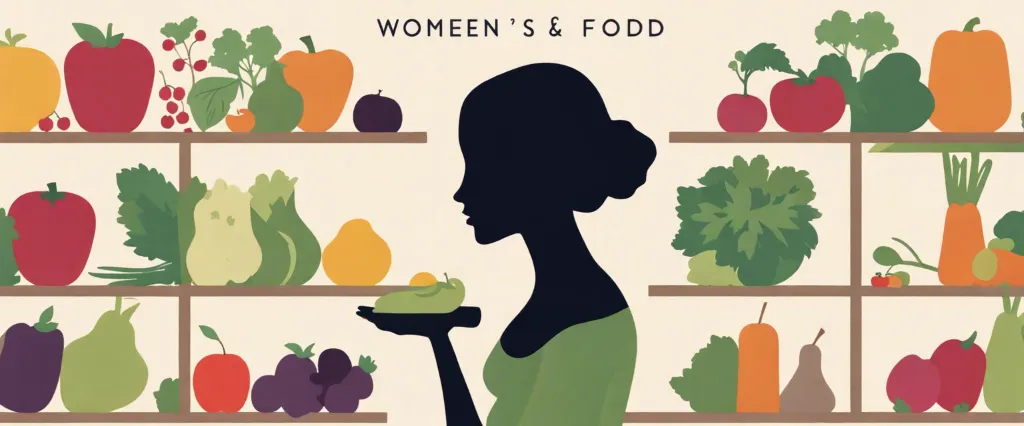In her powerful book, “Women Food and God” acclaimed author Geneen Roth unravels the complex relationship between women, their bodies, and their spirituality. Drawing from her personal struggles with weight and emotional eating, Roth presents a revolutionary approach to healing one’s relationship with food and finding ultimate fulfillment. With a compassionate and insightful voice, the author offers transformative wisdom that has helped countless individuals break free from the vicious cycles of diets and self-loathing. Through her intuitive guidance and practical exercises, Roth invites readers to embark on a profound journey of self-discovery and self-acceptance.
Chapter 1: The Relationship Between Women, Food, and God
Roth begins by acknowledging that women often struggle with their bodies and food, leading to feelings of shame, guilt, and a vicious cycle of dieting and binge eating.
Roth argues that women’s obsessions with food are not actually about food itself but rather a way to numb and distract from deeper emotional pain. She suggests that food becomes a substitute for love, comfort, and spiritual fulfillment, ultimately leading to a disconnection from one’s true self. The author emphasizes that the focus should not be solely on what women eat, but rather on why they are eating.
Roth also delves into the concept of God and how it relates to women’s relationship with food. She asserts that the idea of God has been heavily influenced by patriarchal societies, resulting in women feeling unworthy and constantly striving for perfection. This distorted view of God can further perpetuate disordered eating patterns and self-destructive behaviors.
Throughout the chapter, Roth shares personal anecdotes and insights from her own journey of healing the relationship between women, food, and God. She encourages readers to cultivate self-awareness, to question their beliefs and patterns, and to develop a deeper connection with their spirituality.
In summary, Chapter 1 explores the complex and multifaceted relationship between women, food, and God. Roth highlights the underlying emotional issues that drive disordered eating patterns in women and criticizes the societal expectations and distorted views of God that contribute to these struggles. Ultimately, the chapter encourages readers to embark on a deeper journey of self-discovery and spiritual awakening to heal their relationship with food and themselves.
Chapter 2: Exploring Emotional Eating Patterns
Roth begins the chapter by explaining that emotional eating is often a response to unexpressed emotions or unresolved issues. She introduces the idea that the way one eats mirrors how they live, and that examining one’s relationship with food can provide valuable insights into their emotional state.
Roth emphasizes the importance of mindfulness and being present while eating. She argues that by paying attention to the experience of eating, individuals can uncover their emotional triggers and patterns. The author also stresses the significance of self-compassion and non-judgment in this process, as self-criticism only perpetuates the cycle of emotional eating.
To further illustrate her points, Roth shares her own personal experiences and those of her clients. She provides anecdotal evidence of people using food as a coping mechanism for various emotional states such as boredom, stress, anxiety, and loneliness.
Roth explores the concept of “eating in secret” and how it often relates to shame and a desire to hide oneself. She encourages individuals to examine their motivations behind secretive eating and to challenge the underlying self-judgment that may drive this behavior.
Towards the end of the chapter, Roth outlines a variety of emotions that frequently lead to emotional eating, including anger, sadness, fear, and longing. She emphasizes the importance of self-awareness and identifying individual triggers to break free from the cycle of emotional eating.
Through her compassionate approach and personal anecdotes, she encourages individuals to be present, non-judgmental, and self-aware when it comes to their relationship with food. By understanding and addressing the emotions that trigger overeating, individuals can begin to find lasting solutions and develop a healthier relationship with food.
Chapter 3: Cultivating Mindful Eating Practices
The author emphasizes the importance of being fully present when we eat, without distractions or judgments. She believes that by establishing mindful eating habits, we can reconnect with ourselves and develop a healthier relationship with food.
Roth begins by acknowledging that most people have a difficult relationship with food. She states that our eating habits are often influenced by external factors, such as social pressures or emotional triggers. To counter this, the author encourages readers to pay attention to their internal cues instead, such as hunger and fullness signals.
To cultivate mindful eating, Roth suggests implementing simple yet powerful practices. One such practice is called “Inquiry,” where one deeply investigates their relationship with food. By examining beliefs, patterns, and emotions associated with eating, one can gain insight and break free from destructive habits.
Roth also emphasizes the importance of slowing down and savoring each bite. By taking the time to truly taste and appreciate food, we can derive more satisfaction and decrease the urge to overeat. She recommends starting with one meal a day and gradually expanding the practice.
Furthermore, the author highlights the significance of non-judgmental awareness. Instead of labeling food as “good” or “bad,” Roth encourages readers to approach eating with curiosity and openness. This way, we can become more attuned to how different foods affect our bodies and make choices that truly nourish us.
By being present, observing internal cues, investigating our relationship with food, and savoring each bite, we can develop a healthier and more fulfilling approach to eating.
Chapter 4: Healing Your Relationship with Food

She stresses that giving oneself permission to eat any food can actually lead to more balanced and healthy choices.
Roth explores the idea that our relationship with food is a reflection of our relationship with ourselves and our emotions. She argues that our eating patterns are often a coping mechanism for dealing with emotions such as anger, sadness, or fear. Identifying and acknowledging these emotions is crucial for healing our relationship with food.
The chapter also delves into the concept of “radical self-acceptance” and how it relates to food. Roth argues that accepting ourselves as we are, with all our flaws and imperfections, is essential for overcoming emotional eating. By letting go of self-judgment and embracing self-compassion, we can begin to transform our relationship with food.
Roth provides practical tools and exercises to help readers explore their emotions and eating patterns. This includes techniques such as journaling, meditation, and being mindful of hunger and fullness cues. She encourages readers to pay attention to the underlying emotions driving their food choices and to develop alternative coping mechanisms to deal with these emotions.
Chapter 5: Embracing Your Body and Self-Acceptance
Roth starts by acknowledging that most women have a complicated relationship with their bodies, often based on societal beauty standards and the constant pressure to be thin. She challenges these norms, arguing that our bodies are not the enemies but rather gateways to a deeper understanding of ourselves.
The author shares her own struggles with body image and the revelation she had when she let go of restrictive diets and self-hatred. Roth encourages readers to stop fighting their bodies and instead start listening to them. She stresses the importance of nourishing oneself with loving kindness and compassion.
Roth introduces the concept of “Radical Belief,” which involves accepting and loving ourselves unconditionally. She explains that by embracing our bodies as they are, we open ourselves up to self-acceptance and self-discovery. The author also highlights the role of mindfulness and staying present in the moment as crucial tools for healing.
To cultivate self-acceptance, Roth suggests practical exercises such as creating a gratitude list for one’s body, standing in front of a mirror and saying positive affirmations, and challenging negative self-talk. Additionally, she encourages embracing physical sensations, like hunger and fullness, and acknowledging them without judgment.
Chapter 6: Nurturing Your Spirituality and Inner Life
Roth begins by asserting that our relationship with food is often a reflection of our relationship with ourselves and our spirituality. She argues that food becomes a substitute for the spiritual nourishment that we may be lacking. When we don’t nurture our inner life, we turn to food to fill the void.
The author suggests that one’s spiritual nourishment can come from various sources, such as meditation, prayer, or simply spending time in nature. She emphasizes the need to create quiet spaces in our lives, where we can listen to our inner voice and connect with something larger than ourselves. This connection allows us to shift our focus away from food and towards a deeper sense of fulfillment.
Roth also delves into the concept of surrender, explaining that by surrendering to the present moment and accepting what is, we can find peace and healing. It is through surrendering that we can release our attachment to food as a coping mechanism and instead become more attuned to our inner needs.
Additionally, the chapter explores the significance of trust in the process of nurturing spirituality and cultivating a healthy relationship with food. Roth highlights that trusting ourselves and our bodies is crucial in order to heal the wounds that have led to unhealthy eating patterns.
By fostering spiritual connections, surrendering to the present moment, and building trust within ourselves, we can find true fulfillment and heal our relationship with food.
Chapter 7: Letting Go of Restrictive Dieting Mentality
Roth begins by explaining that most diets are based on restriction and control, including rules about what to eat and when to eat. However, she argues that this approach only reinforces the idea that food is something to be feared and obsessed over. Instead, Roth encourages readers to embrace a mindset of abundance, where the focus is on nourishing the body and enjoying food without guilt.
The author shares personal anecdotes and experiences from her own battle with restrictive dieting, highlighting the detrimental effects it had on her overall well-being. Roth emphasizes the notion that diets are not sustainable in the long term, as they often lead to binging and feelings of guilt and shame.
To break free from the restrictive dieting mentality, Roth suggests shifting the focus from external rules to internal trust. This involves reconnecting with one’s own hunger and fullness cues, as well as learning to listen to the body’s needs and desires. By cultivating self-awareness and self-compassion, individuals can rebuild a healthy relationship with food and find peace with their bodies.

Chapter 8: Finding Freedom and Peace with Food
Roth emphasizes that to find freedom from food obsession, one needs to understand the underlying causes of their overeating or bingeing.
The chapter begins by discussing the crucial role of self-compassion in the process of healing one’s relationship with food. Roth encourages readers to stop relying on external solutions, such as diets or restriction, and instead turn inward to uncover the emotional and psychological triggers behind their eating patterns.
Roth introduces the concept of “splitting,” which reflects the tendency to categorize food as either “good” or “bad.” She urges readers to let go of this black-and-white thinking and adopt a more flexible approach towards food, where no food is off-limits or forbidden. This shift in mindset helps individuals develop a healthy relationship with food, allowing them to enjoy it without guilt or anxiety.
Moreover, the author emphasizes the importance of being present in the moment while eating. By practicing mindful eating, individuals learn to savor and enjoy each bite, paying attention to their body’s signals of hunger and fullness.
Roth also discusses the connection between food and emotions, highlighting the need to cultivate emotional resilience. She suggests exploring alternate ways of managing emotions, such as journaling, therapy, or engaging in other activities that provide comfort and support.
By developing self-compassion, embracing flexibility in their relationship with food, practicing mindful eating, and addressing emotional triggers, individuals are empowered to establish a healthy and balanced connection with nourishment.
After Reading
In conclusion, “Women Food and God” by Geneen Roth offers a deeply personal and insightful exploration of the complex relationship between women, food, and spirituality. Roth highlights the inherent connection between emotional eating and deeper psychological issues, providing practical tools and strategies for breaking free from destructive patterns. By encouraging readers to fully embrace their hunger, both physically and spiritually, Roth empowers women to listen to their bodies, trust their instincts, and ultimately find peace and liberation from the endless cycle of diets and self-hatred. With her compassionate and authentic voice, Roth offers a transformative journey towards self-acceptance and nourishment that extends far beyond the plate, reminding women that true fulfillment comes from within.
1. Tools of Titans” by Timothy Ferriss: This book is a comprehensive collection of interviews and insights from some of the most successful individuals across various fields. Ferriss uncovers the habits, tactics, and frameworks these titans employ to achieve extraordinary results. It’s an invaluable resource for personal and professional growth.
2. The Power of Now” by Eckhart Tolle: Tolle delves into the concept of mindfulness and the ability to live in the present moment. Through his profound teachings, he guides readers on a transformative journey toward freedom from past regrets and anxieties about the future. This book offers a powerful perspective on finding inner peace and cultivating a deep sense of tranquility.
3. Stop Walking on Eggshells” by Paul T. Mason and Randi Kreger: This book is an essential guide for anyone dealing with someone suffering from borderline personality disorder (BPD). Mason and Kreger provide crucial insights, advice, and coping strategies to help loved ones create healthier relationships while maintaining their own emotional well-being.
4. Atomic Habits” by James Clear: Clear explores the power of small habits and how making incremental changes can lead to remarkable transformations. Through practical advice and scientific research, he offers a step-by-step guide to breaking bad habits, building good ones, and improving overall productivity. This book is a game-changer for those seeking to make lasting positive changes in their lives.
5. The Gifts of Imperfection” by Brené Brown: Drawing upon years of research, Brown explores the notion of wholehearted living and embracing imperfections. She uncovers the factors that hinder us from accepting ourselves fully, such as shame and fear, and offers thoughtful guidance on developing resilience, self-compassion, and authentic connections with others. This book serves as an uplifting reminder to embrace our vulnerabilities and live wholeheartedly.




